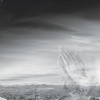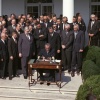
An Interview with Makoto Fujimura
Makoto Fujimura is an artist, writer, and speaker who is recognized worldwide as somebody who promotes a Christian worldview. A Presidential appointee to the National Council on the Arts from 2003-2009, Fujimura served as an international advocate for the arts, speaking with decision makers and advising governmental policies on the arts.
Fujimura's work is exhibited at galleries around the world, including Dillon Gallery in New York, Sato Museum in Tokyo, The Contemporary Museum of Tokyo, Tokyo National University of Fine Arts Museum. He is one of the first artists to paint live on stage at New York City's legendary Carnegie Hall as part of an ongoing collaboration with composer and percussionist Susie Ibarra.
Fujimura's second book, Refractions: A Journey of Faith, Art and Culture, is a collection of essays bringing together people of all backgrounds in a conversation and meditation on culture, art, and humanity. In celebration of the 400th Anniversary of the King James Bible, Crossway Publishing commissioned and published The Four Holy Gospels, featuring Fujimura's illuminations of the sacred texts. His latest project, The Golden Sea, takes its name from a series of paintings by the artist. Fujmura is the recipient of the 2014 Arts and Religion Award given by the American Academy of Religion. He recently spoke with Acton intern Cait Hilton and managing editor Ray Nothstine.
R&L: You've focused a lot of your work and ideas on what you call Culture Care. What does that mean?
Makoto Fujimura: Culture Care is a vision to see the culture as an ecosystem and to steward rather than to fight over culture territories. We need to change the metaphor from a culture war mindset to culture care. We need to make progress towards changing minds. If you're conservative or liberal, a culture war mindset is detrimental to your position. You're always losing; you're always compromising. It just doesn't make sense from the standpoint of responsible social discourse.
It's essential to talk to both ideological sides and some people think, "I can't believe I have to defend this sacred position." For conservatives it could be marriage. For liberals it could be rights of expression. Both sides see their positions eroding. But when you look at the arguments of James Davison Hunter, who coined the term "culture wars" in the late 80s or early 90s, he predicted the protracted conflict like we are seeing today. The nature of discourse right now is flawed.
When I was on the National Council for the Arts serving with then chairman, Dana Gioia, who is a remarkable poet himself and a business executive, I noticed him crafting this way of navigating Washington, D.C. He was amazing at working with both sides of the aisle, and he started his conversations with those of different ideologies by talking about the art and literature they loved. The senators and house members and President George W. Bush would end up talking about things that really mattered to them and were related to why they were politically active.
When Dana was speaking before the Senate hearings or private luncheons with the First Lady, he would often begin with a Longfellow poem. He also borrowed from T. S. Eliot and Eliot's view of shaping culture. Stressing the emphasis of driving humanity and how the Christian faith is central to that. So Culture Care comes from that stream and Dana was able to actually implement that as the chairman of the NEA.
That was during the height of the culture wars and the beginning of what are seeing now, which is total polarization and ineffective government, yet he successfully managed to create a coalition of people who care about culture and he moved the needle a little bit toward consensus.
How does an artist today help a society that is striving for truth?
We have to connect truth, goodness, and beauty. Truth without beauty ends up as a black and white frame and is very dogmatic. Beauty without goodness will becomes sterilized and has no impact. And so beauty and truth have to work together and goodness holds everything together in a way that allows for a community to understand itself and an artist to be able to function in a particular setting as someone who can speak the truth. It's important for an artist to expose things we don't normally talk about in the public square.
Look at the great writers–from Walt Whitman to Emily Dickinson and from F. Scott Fitzgerald to Ernest Hemmingway– they all do that, they're kind of exposing some dissonance in culture, but, at the same time, their poetry allows them to create this authentic place. And so art is a great way to see truth and beauty. It's a conduit. It allows you a particular position and standing so truth does not become dogmatic, but it becomes incarnated into our whole life. I speak to these issues in my upcoming book about culture care.
I was on a panel with Jesse Jackson once and he looked straight at me, and he said, "If you want to start a movement of any kind, civil rights included, you have to have artists." You can talk about injustice, oppression, and truth all day, but it's not until Marvin Gaye starts singing and jazz musicians start playing, that it becomes real. Until a singer-songwriter writes a song that everybody's singing, including your enemy, the movement doesn't take off. Historically that's true of any kind of movement, and so in that sense, what the artist brings actually taps into the dream that we might have about a movement. Truth often works that way. It's important that artists can read an audience and tap into a pivotal event and bring a greater meaning and expression to what is unfolding.
So if Jesus and God are the ultimate artists, in your work of the Four Holy Gospels, what were the challenges of depicting the Gospels through art? The challenge is getting out of the way and illuminating the Word without adding anything to it. So I first looked at discovering what is the function of an artist. And then I knew, even devoid of images, the Bible is a visual text. The artist is designing but illuminating the Word so that it is readable and beautiful. I was trying to listen to the Spirit, using my slice of expression to illuminate the Word. It's a fellowship with the Spirit to go deeper. That is a spiritual challenge and discipline.
I felt so unworthy doing this. And yet what kept on coming back to me was that this invitation was to the feast. I wanted to contribute to an understanding of upholding and beholding the Word of God as the word of the feast. That is a great privilege. I would come out of my studio kind of staggering because I had spent a day meditating on one word and trying all I could do to compress that reality.
The folks at Crossway Publishing were so wonderful to work with because they took care of the details. One page went through six color corrections. They didn't complain; they knew that it was important. I was trying to do justice to the Word as it is written to us. How do we worship through that? So when I talk about visual theology, I'm not talking about replacing the Word of God but finding a way to visualize it.

The cover for Fujimura’s first retrospective monograph entitled Golden Sea.
In the Golden Sea video, you explain that every theme and technique that you've tried to capture is captured. Could you elaborate on that?
I was working on the Four Holy Gospels, and I just needed to work on something else because it was so intense and I ended up stretching the canvas. I didn't intend for it to be anything but a backdrop and I started putting layers and layers on it. I was working on the Four Holy Gospels for a year and a half, so throughout that time I was just working on the background. And so there's at least 80 days on there by the time I realized what it was, and my son came in to film for Crossway and he asked, "Dad, what is this painting?" And I said, "I don't know, it's just something I'm doing." And he said, "This is everything you've done." And I stepped back and I was like that's quite a statement. And then my gallery owner, Valerie, came the next week and she said the same thing. So I thought, "This is amazing!" I guess I didn't realize maybe that's why it was so good because by virtue of letting this be something of leisure, I was out of the way completely. The work began to just take over. But intuitively that's what you want to see happen when you're creating or writing, that's what happened with this painting. And when I looked at it, I laughed, and I knew they were right. There's something to this that I've always wanted to do and I never felt like it was the right time and I was using a kind of silk and paper that's no longer available, so it's something that I can never do again in the same way. I can work in a series and create other pieces, but that particular piece is absolutely unique to that time and the ecosystem of art that is endangered and disappearing. So there is a little bit of sadness to it because there is a finality that can't ever be replicated with another piece.
And did you create 'Walking on Water' with the intent of entering it into the Grand Rapids Art Prize?
No. It was strictly a response to the earthquake and Tsunami in Japan. After 9/11, I worked for a decade dealing with fire. And now I had to deal with water and imaginatively try to work through this question, "Can you walk on water?" I was trying to answer that given the reality of the circumstance and devastation in Japan.

Fujimura’s Walking on Water - Azurite on display at Acton’s headquarters
during the 2014 Artprize in downtown Grand Rapids, Mich.
The Golden Sea video captures the process of this, so your readers can watch the process of the creation of the painting. And I used a similar azurite that was given to me by a pigment shop owner in Japan. She's in the film and she has recently saved a particular type of azurite that has a certain kind of impurity in them, so its fractions are a little different than the pure azurite.
But this azurite comes from the top of the mines that is retrieved by hand, similar to using dynamite in order to get copper faster. So the azurite that I use for that painting is very rare. My pigment shop finds these somehow. So in a way, this is a collaboration with the Japanese people.
I realized that's exactly the kind of expression that I wanted to do to honor the victims of 9/11 and other disasters. I showed it in New York to help my gallery recover from Hurricane Sandy. And then it went to Yale for mini-retrospective there. I've shown it in various places. I believe this piece is meaningful to those who have experienced great challenges.
How does sharing in Christ's suffering carry an artist to something greater?
Christ Himself is an artist. God is the Great Artist and Christ is the embodiment of humanity and divinity, fully human, fully divine, fully artist. William Blake said, "Jesus was the only artist who ever lived." I agree with that. I think His artistry was about salvation, but it doesn't end there, it begins there. His artistry not only brings us to a redeemed humanity and reconciled nature, but also to a new world and new Heaven. Christ completely changes the structure of the materialist universe that we know today. That's the grand work of an artist.
Artists really understand that there's suffering involved, there's sacrifice, and there's discipline that we need to develop. We don't expect people to get it. We almost expect everything that we create will be misunderstood. Often there is a feeling that people will take advantage of us and hijack our writings, our paintings, or our music. That's okay because Jesus walked a path of isolation and was misunderstood yet fulfilled His mission. Artists can see that clearly when we follow Christ. We don't have to have a bestseller or even praise from people. It's enough that we have our conviction, given by the Spirit to inhabit a unique niche.
I call it my small slice of expression because when I was in art school in Japan for graduate school, there were a lot of people more gifted than I was. But I had this one particular way of painting, capturing reality, and expressing something that only I could do. Even before I was a Christian I knew that it was a gift because when I am tapped into that reality, something goes through me. I couldn't explain it. It was like magic and it created this deeper love, and so I cultivated that, and here I am, thirty years later, a successful artist that was just trying to be faithful to that small slice of expression.
It's a journey toward focusing on who you are, what you're created to do, and who you're not. Sometimes failure is more important than success. A lot of times we think that artists look for success but Eliot says in Four Quartets, "For love would be love of the wrong thing." We are often not ready for the very thing we crave. At the same time, Jesus shows the way and he experienced suffering to give us a new image, a new definition of success. The cross is critical for the believer to understand and grasp art, and the art of life.












